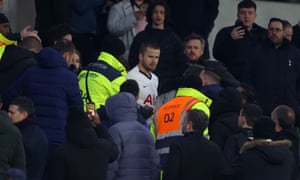Eric Dier’s trip through the fourth wall was an oddly moving act of defiance | Barney Ronay | Football
“Where can there be a place in the game for a man of such extravagant talent, a man of such wicked temperament? A man who has now … OH MY GOODNESS ME!!! He has KICKED … He has PUNCHED A FAN!!! Eric Cantona has jumped in and SCISSOR KUNG FU KICKED a fan. I have never seen such a disgraceful incident in all my years in football. Cantona must be thrown out of the game. I care not one jot about his supreme talent!!”
The words of the young firebrand Jonathan Pearce there. Pearce was commentating on the radio as Cantona scissor kung fu kicked – excellent football-style technique descriptor there – an abusive supporter at Selhurst Park in January 1995. In the process he captured perfectly the mind-boggling weirdness of a moment where modern football became, ahead of time, a truly interactive entertainment.
There was no equivalent sense of outrage when Eric Dier climbed the hoardings and entered the crowd at the end of Tottenham Hotspur’s FA Cup defeat by Norwich City on Wednesday night. For obvious reasons. Dier didn’t attack anyone. He didn’t really do anything wrong, other than giving off an alluring sense of menace while jumping, quite slowly, over some seats.
The common territory is that Dier and Cantona both broke the fourth wall, crossing the spatial and emotional boundary between observer and performer, something English sport finds particularly transgressive. Dier’s crime was to break character as a paid entertainer; and to risk wider disorder that might have endangered stewards and bystanders.
With a little distance two things seem clear. First it is extraordinary that 25 years on from Selhurst Park there have been so few incidents of this type in modern football. All that trapped rage. And in the middle of it, what poise! What dutiful respect of personal space! But then, anonymity is a useful cloak. Give a man a mask and he’ll tell you the truth; bury him in a crowd and he’ll gleefully express the very worst of himself.
Beyond this it is striking how different the response has been. Dier has drawn a tide of sympathy, support and applause. Correctly so, too. He was trying to protect his brother, which is right up there with saving his dog or making sure the mail gets through when it comes to hitting the big emotional bullseyes. Climbing up through those rows of plastic seats, he looked angry but also noble and sad and messianic, like the last polar bear on earth in lone pursuit of the retreating snowline.
Dier was also successful. The spectator in question beat a limp retreat, having realised that abusing people from behind a fence might actually have real-life consequences. As a wise man once said: “Don’t make threats you cannot and will not back up.” Dier will be punished, but hopefully with lenience. When he looks back on his career, he won’t regret doing it.

But I suspect there are more diffuse reasons for all that sympathy. For a start, these days you don’t have to be sporting celebrity to know what random, anonymised abuse feels like. Rage is all around us, one of the three great gifts of the internet’s gleaming new frontier, along with horse porn and disinformation.
To see someone stand up to that wall of noise was oddly moving, not least for those who get it most on social media judging by the likes flying around in the Twitter debrief. Whereas most dissenters seemed to be accounts called things such as NorthStandBloke or MaroonArmyblock47. No names, no faces. Make of that what you will.
And yet there is also something false in the urge to take issue too zealously with the broad group that is “football supporters”, to lambast the state of the culture, or to point, as everyone does now, at one loosely defined group and say they are the problem.
Sympathy for the angry football fan. It’s not a fashionable cause. The most obvious point is the right to barrack. There is something maddening about those who say I’ve paid my money so I’m entitled to say what I want, which is clearly incorrect. But it is also true that we all have a voice, that a cat may look at a king, and that there is something vital about an uncouth dissenting spirit. At the Sydney Cricket Ground there is a life-sized statue of Yabba in the seats, a legendary loudmouth who berated successive touring England teams in the early 20th century. Commoners hurling bile, cauliflowers and inelegant language at every preening public figure in their line of sight has always been a vital part of the culture.
Still, this doesn’t quite cover it. For one thing the right to barrack is so often abused by those who want to punch down, by racists and cranks, by those spreading hate rather than letting off steam. Plus, the current levels of ambient anger feel like more than this; and indeed more than football, which has only ever been a bellwether.
Do you feel it too? The world has become an oppressive place. Don’t push us. Because, frankly, we’re all pretty close to the edge. I blame the unique pressures of the unceasing, insatiably talkative digital world. All human rage is essentially territorial, and we have no space, no respite, are invaded constantly. So people chafe and cry out.
Anger feeds itself. The voices in your head and on your screen elide with the voices in your ears. Dier, who gets plenty of this, reached his own breaking point on Wednesday. Perhaps this is why it seemed so oddly refreshing, evidence of some recognisable human agency. Rage, divisiveness, demonising and “othering”: this has become the game, like it or not. And right now resistance is all we have.

